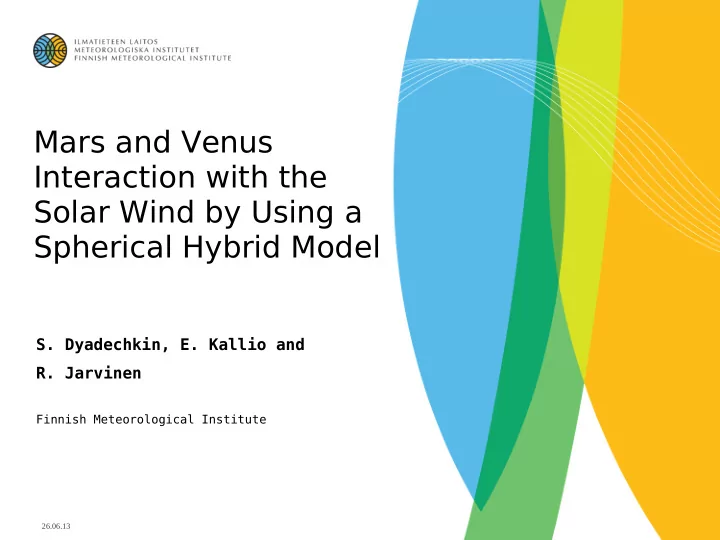

Mars and Venus Interaction with the Solar Wind by Using a Spherical Hybrid Model S. Dyadechkin, E. Kallio and R. Jarvinen Finnish Meteorological Institute 26.06.13
Outline 1. Motivation 2. HYB-model 2.1 Main features of hybrid approach 2.2 Basic hybrid equation 2.3 Spherical hybrid model 2.4 Cartesian vs spherical 3. Results of Venus and Mars interaction with the Solar wind 4. Summary and perspectives 26.06.13
Motivation • Question: How flowing plasma interacts with The Moon : no intrinsic B , no atmosphere Mercury : intrinsic B, no atmosphere Venus : no intrinsic B , atmosphere Mars : no intrinsic B , atmosphere Titan : no intrinsic B , atmosphere Tool: Global Quasi-Neutral Hybrid model 26.06.13
HYB: The FMI hybrid code HYB is a 3-D Cloud-In-Cell Quasi-Neutral Hybrid code Semi-kinetic plasma matter: particle ions, massless electron fluid. Leapfrog algorithm to integrate the eq's forward in time. Boris-Buneman integrator for the Lorentz force. Divergence-free Faraday propagation (Yee lattice). Spatial Cartesian grid for the field quantities (hierarchically refinable) . Finite sized ion clouds (macroparticles) with volume weighting. Simulation macroparticle is a finite sized particle cloud Cloud size = local grid cell size. Developed for the planetary plasma interactions. Object-oriented C++ programming Runs on a single CPU 26.06.13
Basic Hybrid equations The HYB model family HYB-Mercury HYB-Venus Ions Electrons Maxwell's eq's HYB-Moon HYB-Mars HYB-Titan Other applications Typically 10⁵...10⁶ grid cells and 10⁶...10⁸ computational particles, 400 000 cells (30 particles/cell) . 26.06.13
Solving the equations 0) Initial state for the magnetic field and the 5) Propagation of the magnetic field particles + parameters 1) Current density 6) Propagation of the particles 2) Charge density of the electron fluid 3) Velocity field of the electron fluid 26.06.13
Leapfrog algorithm 26.06.13
Divergenceless gridded B B stored as fluxes on six cell faces, E calculated at cell nodes. Fluxes propagated by taking a line integral of curl(E) using a linear approximation between the nodes. This construction gives a stationary divergence of the magnetic field in a cell, i.e. initially divergence-free B stays that way. Linear interpolations between cells, faces and nodes. Yee lattice 26.06.13
Spherical grid Why we need Spherical Spherical cell coordinates 1. Better grid resolution (Natural Grid Refinement) 2. Boundary conditions (Natural Boundary Conditions) 3. Self – consistent ionosphere (for Venus ~ 20km) Interpolations between Macroparticle in Cartesian spherical grid elements and spherical grids CN - cell to node NC - node to cell FC - face to cell NF - node to face EN - edge to node 26.06.13
Cartesian vs Spherical Spherical Worlds Spherical Worlds Planetary worlds are spherical Grid Resolution Grid Resolution In SC the grid size decreases automatically near the obstacle Obstacle Boundary Conditions Obstacle Boundary Conditions In SC the planetary surface overlaps r-constant surface of the grid Interpolation Interpolation In CC interpolations between the grid elements are simpler Boundary Conditions Boundary Conditions In CC it is easier to set the external boundary conditions Pole Problems Pole Problems In SC there are two singularity – poles 26.06.13
Solar wind – Venus interaction Input parameters Initial Magnetic Field: B x = 0, B y = 10nT, B z = 0 Particle populations: (Similar as in Jarvinen at al, 2009) 0 .Solar Wind Population H+, n = 1.5·10⁶ m -3 , T = 10⁵ K. 1 .Solar Wind Population H+, n = 14·10⁶ m -3 , T = 10⁵ K, V z = 4.3·10⁵ m/s. 2. Ionospheric Population O+, Emission rate = 2.0·10 25 s -1 , T = 2000 K. 3. Exospheric Populations H+, Emission rate = 2.0·10 23 s -1 , T = 6000 K. O+, Emission rate = 4.0·10 24 s -1 , T = 5600 K. H+, Emission rate = 6.2·10 24 s -1 , T = 200 K. MacroParticles: particles/cell=30. Grid stucture: Spherical dr = 202 km, dθ = 3.0 o , dφ = 6.0 o 26.06.13
Solar Wind - Venus Interaction. Steady state regime (400s) S. Dyadechkin, E. Kallio and R. Jarvinen. A new 3D spherical hybrid model for solar wind interaction studies . JGR. Submitted. 26.06.13
Solar Wind - Venus Interaction. Steady state regime (400s) S. Dyadechkin, E. Kallio and R. Jarvinen. A new 3D spherical hybrid model for solar wind interaction studies . JGR. Submitted. 26.06.13
Solar Wind - Venus Interaction. Steady state regime (400s) S. Dyadechkin, E. Kallio and R. Jarvinen. A new 3D spherical hybrid model for solar wind interaction studies . JGR. Submitted. 26.06.13
Solar Wind - Venus Interaction 26.06.13
Solar wind – Mars interaction Input parameters Initial Magnetic Field: B x = 0, B y = 4.7nT, B z = 0 Particle populations: 0 .Solar Wind Population H+, n = 3.1·10⁵ m -3 , T = 10⁵ K. 1 .Solar Wind Population H+, n = 3.1·10⁶ m -3 , T = 10⁵ K, V z = 4.3·10⁵ m/s. 2. Ionospheric Population O+, Emission rate = 6.0·10 24 s -1 , T = 2000 K. 3. Exospheric Populations H+, Emission rate = 6.28·10 22 s -1 , T = 6000 K. O+, Emission rate = 1.28·10 24 s -1 , T = 5600 K. H+, Emission rate = 2.0·10 24 s -1 , T = 200 K. MacroParticles: particles/cell=30. Grid stucture: Spherical dr = 136 km, dθ = 3.6 o , dφ = 7.2 o 26.06.13
Solar Wind - Mars Interaction. Steady state regime (180 s) 26.06.13
Solar Wind - Mars Interaction. Steady state regime (180 s) 26.06.13
Solar Wind - Mars Interaction. Steady state regime (180 s) 26.06.13
Solar Wind - Mars Interaction 26.06.13
Summary and Perspectives Spherical HYB model is ready to use Spherical HYB model has some advantages compared to Cartesian HYB a. Better grid resolution b. Natural inner boundary conditions Perspectives Self-consistance ionosphere. (For Venus Δr ~ 20 km) Nonuniform grid (Δr != const) Magnetized objects (Mercury, Earth ...) Testing, developing. 26.06.13
Recommend
More recommend